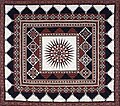English paper piecing: Difference between revisions
Added {{Unreferenced}} tag |
Citation bot (talk | contribs) Removed proxy/dead URL that duplicated identifier. | Use this bot. Report bugs. | Suggested by Abductive | Category:Quilting | #UCB_Category 34/49 |
||
| (10 intermediate revisions by 10 users not shown) | |||
| Line 1: | Line 1: | ||
{{Unreferenced|date=March 2021}} |
|||
[[File:English_paper_piecing.jpg|thumb|Star shapes made by paper piecing]] |
[[File:English_paper_piecing.jpg|thumb|Star shapes made by paper piecing]] |
||
English paper piecing is a method of |
English paper piecing is a method of patchwork where fabric is wrapped around fabric shapes made of thin paper cardboard or heavy paper. Once the shapes are wrapped and ready, the sewer will hand sew the shapes together one at a time until the shapes become an intricate design. The paper or cardboard is removed once the shape has been sewn to another shape on all sides. This is an art for those who like to sew by hand. |
||
The practice's name comes from the fact that it |
The practice's name comes from the fact that it originated in England in the 1770s.<ref>{{Cite web |title=What is English Paper Piecing - How it's done and its history {{!}} European Quilting Supplies |url=https://www.eqsuk.com/news/consumer/what-is-english-paper-piecing-how-it-s-done-and-it-s-history/226 |access-date=2023-03-04 |website=www.eqsuk.com}}</ref> Once a shape, bloc, rosette, or finished piece has been made, the papers are removed, leaving the fabric as the remaining item. |
||
[[File:Patchwork pieces (AM 17441-3).jpg|thumb|243x243px|Backside of fabric pieces, shaped into hexagons by pieces of paper]] |
|||
English paper piecing should not be shortened to "paper piecing", as that term includes [[Foundation piecing|Foundation Paper Piecing]] (which uses a sewing machine to sew the fabric shapes together along lines on the paper) as well, nor should the two distinct paper piecing techniques be confused with each other.<ref>{{Cite journal |last1=Leake |first1=Mackenzie |last2=Bernstein |first2=Gilbert |last3=Davis |first3=Abe |last4=Agrawala |first4=Maneesh |date=2021-07-19 |title=A mathematical foundation for foundation paper pieceable quilts |journal=ACM Transactions on Graphics |volume=40 |issue=4 |pages=65:1–65:14 |doi=10.1145/3450626.3459853 |issn=0730-0301|doi-access=free }}</ref> |
|||
English Paper Piecing should not be confused with Foundation Piecing, nor should its name be shortened to calling it paper piecing. Calling it paper piecing only confuses the art of English Paper Piecing. |
|||
Foundation Piecing is similar in that is uses paper to help create fabric shapes but it uses a sewing machine to sew the fabric shapes together. Paper is used to create sharper points and more detail. Paper is removed after sewing. |
|||
== References == |
== References == |
||
{{reflist}} |
{{reflist}} |
||
== External links == |
|||
* [https://books.google.com/books?id=sKNKEAAAQBAJ Flossie Teacakes' Guide to English Paper Piecing - Google Books] |
|||
{{Layered textiles}} |
{{Layered textiles}} |
||
[[Category:Quilting]] |
[[Category:Quilting]] |
||
Latest revision as of 09:12, 9 February 2024

English paper piecing is a method of patchwork where fabric is wrapped around fabric shapes made of thin paper cardboard or heavy paper. Once the shapes are wrapped and ready, the sewer will hand sew the shapes together one at a time until the shapes become an intricate design. The paper or cardboard is removed once the shape has been sewn to another shape on all sides. This is an art for those who like to sew by hand.
The practice's name comes from the fact that it originated in England in the 1770s.[1] Once a shape, bloc, rosette, or finished piece has been made, the papers are removed, leaving the fabric as the remaining item.

English paper piecing should not be shortened to "paper piecing", as that term includes Foundation Paper Piecing (which uses a sewing machine to sew the fabric shapes together along lines on the paper) as well, nor should the two distinct paper piecing techniques be confused with each other.[2]
References
[edit]- ^ "What is English Paper Piecing - How it's done and its history | European Quilting Supplies". www.eqsuk.com. Retrieved 2023-03-04.
- ^ Leake, Mackenzie; Bernstein, Gilbert; Davis, Abe; Agrawala, Maneesh (2021-07-19). "A mathematical foundation for foundation paper pieceable quilts". ACM Transactions on Graphics. 40 (4): 65:1–65:14. doi:10.1145/3450626.3459853. ISSN 0730-0301.

